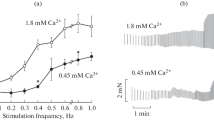Summary
In a comparative study, the mechanical and electrical responses of the guinea pig's papillary muscles and strips of the turtle's and frog's ventricles to various stimulation patterns were investigated. Typical forcefrequency relationships were found to be present in all preparations. It is, however, much more pronounced in the guinea pig's heart than in the other preparations. Striking differences exist between the warm-blooded and the cold-blooded animals, as far as “pure frequency potentiation” is concerned, i.e., the frequency dependence of the maximal actively developed force after a certain resting period (test-interval) following a series of conditioning rhythmical stimuli. Whereas in the guinea pig's papillary muscle the amplitude of optimal test contraction increases with the frequency of foregoing stimuli, the amplitude is depressed in the cold-blooded preparations by a rise of frequency. This effect is found to be due to the shortening of the action potential. Thus the mechanical response of cold-blooded preparations seems to depend primarily on the duration of depolarization under different conditions of stimulation. In the guinea pig's papillary muscle, the same changes in the time course of depolarization can be observed, but their effect on the contractile force cannot be revealed in such experiments. A much more predominant role in the force development of a papillary muscle may be attributed to the immediate influence of frequency on the contractile mechanism, i.e. to the pure frequency potentiation which does not exist in the myocardium of cold-blooded animals. These differences may be explained by the different development of Ca++ stores of the sarcoplasmic reticulum in heart muscle of cold- and warm-blooded animals.
Similar content being viewed by others
References
Antoni, H., Jacob, R., Kaufmann, R.: Mechanische Reaktionen des Frosch- und Säugetiermyokards bei Veränderung der Aktionspotential-Dauer durch konstante Gleichstromimpulse. Pflügers Arch.306, 33–57 (1969).
—, Rotmann, M.: Zum Mechanismus der negativ inotropen Acetylcholin-Wirkung auf das isolierte Froschmyokard. Pflügers Arch. ges. Physiol.300, 67–68 (1968).
Bleichert, A., Reichel, H.: Die Hemmung der Erschlaffung beim Herzmuskel des Kalt- und Warmblüters. Pflügers Arch. ges. Physiol.276, 242–249 (1962).
Carsten, M. E.: Cardiac sarcotubular vesicles: effects of ions, ouabain and acetylstrophantidin. Circulat. Res.20, 599–605 (1967).
Edmands, R. E., Greenspan, K., Fisch, Ch.: Electrophysiological correlates of contractile change in mammalian and amphibian myocardium. Cardiovasc. Res.3, 252–260 (1968).
Hasselbach, W., Makinose, M.: Die Calciumpumpe der “Erschlaffungsgrana” des Muskels und ihre Abhängigkeit von der ATP-Spaltung. Biochem. Z.333, 518–528 (1961).
Heintzen, P., Kraft, H. G., Wiegmann, O.: Über die elektrische und mechanische Tätigkeit des Herzstreifenpräparats vom Frosch in Abhängigkeit von der Temperatur. Z. Biol.108, 401–411 (1956).
Kavaler, F.: Membrane depolarization as a cause of tension development in mammalian ventricular muscle. Amer. J. Physiol.197, 968–970 (1959).
Kedem, J., Mahler, Y., Rogel, S.: The effect of heart rate on myocardial contractility during single and paired pulse stimulation “in vivo”. Arch. int. Physiol. Biochem.77, 880–892 (1969).
Koch-Weser, J., Blinks, J. R.: The influence of the interval between beats on myocardial contractility. Pharmacol. Rev.15, 601–652 (1963).
Kruta, V., Braveny, P.: Restitution de la contractilité du myocarde entre les contractions et phénomènes de potentiation. Arch. int. Physiol.69, 645–667 (1961).
——: Rate of restitution and self-regulation of contractility in mammalian heart muscle. Nature (Lond.)197, 905–906 (1963).
Niedergerke, R.: The staircase-phenomen and the action of calcium on the heart. J. Physiol. (Lond.)134, 569–583 (1956).
Palmer, R. F., Posey, V. A.: Ion effects on calcium accumulation by cardiac sarcoplasmic reticulum. J. gen. Physiol.50, 2085–2095 (1967).
Reichel, H., Bleichert, A.: Excitation—contraction coupling in heart muscle. Nature (Lond.)183, 826–827 (1959).
Reiter, M., Stickel, F. J.: Der Einfluß der Kontraktionsfrequenz auf das Aktionspotential des Meerschweinchen-Papillarmuskels. Naunyn-Schmiedebergs Arch. Pharmak. exp. Path.260, 342–365 (1968).
Rogel, S., Mahler, Y.: Consumption and cumulation of the inotropic effect of depolarization. Israel J. med. Sci.6, 90–102 (1970).
Rumberger, E.: Über Korrelationen zwischen der Aktionspotentialdauer und dem zeitlichen Verlauf der Erschlaffung beim Herzmuskel des Warm- und Kaltblüters. Pflügers Arch. ges. Physiol.301, 70–75 (1968).
—: Der Zeitverlauf der Kontraktionsfähigkeit des Herzmuskels nach plötzlichen Entdehnungen während der isometrischen Kontraktion in Abhängigkeit von der Reizfrequenz. Pflügers Arch.318, 353–365 (1970).
—, Retzlaff, E., Reichel, H.: Beitrag zur Frequenz-Potenzierung des Papillarmuskels vom Meerschweinchenherzen. Pflügers Arch.316, R8 (1970).
Sano, T., Suzuki, F., Sato, S.: Mechanism of inotropic action of catecholamines and ouabain in cardiac muscle in relation to changes of action potential. Jap. Heart J.11, 269–290 (1970).
Schaefer, J., Reichel, H., Schwarzkopf, H. J., Rumberger, E., Nordmann, K. J., Sedlmeyer, I., Bleichert, A.: Untersuchungen zur Kraft-Frequenz-Beziehung des menschlichen Herzens. Verh. dtsch. Ges. Kreisl.-Forsch.37, 356–359 (1971).
Simpson, F. O., Dertelis, S. J.: The fine structure of sheep myocardial cells; sarcolemmal invaginations and the transverse tubular system. J. Cell Biol.12, 91–100 (1962).
Sommer, J. R., Johnson, E. A.: Cardiac muscle. A comparative ultrastructural study with special reference to frog and chicken hearts. Z. Zellforsch.98, 437–468 (1969).
Sopis, J. A., Langer, G. A.: Calcium kinetics in frog heart. J. molec. Cell. Card.1, 291–305 (1970).
Staley, N. A., Benson, E. S.: The ultrastructure of frog ventricular cardiac muscle and its relationship to mechanisms of excitation-contraction coupling. J. Cell Biol.38, 99–114 (1968).
Wiegmann, O., Kraft, H. G., Küper, J.: Der Einfluß der Schlagfrequenz auf Aktionspotentiale und Mechanogramme des Herzstreifens in verschiedenen Temperaturbereichen. Z. Biol.109, 270–280 (1957).
Wood, E. H., Heppner, R. L., Weidmann, S.: Inotropic effects of electric currents. Circulat. Res.24, 409–445 (1969).
Woodworth, R. S.: Maximal contraction “staircase” contraction refractory period and compensatory pause on the heart. Amer. J. Physiol.8, 213–249 (1902).
Author information
Authors and Affiliations
Rights and permissions
About this article
Cite this article
Rumberger, E., Reichel, H. The force-frequency relationship: A comparative study between warm- and cold-blooded animals. Pflugers Arch. 332, 206–217 (1972). https://doi.org/10.1007/BF00587448
Received:
Issue Date:
DOI: https://doi.org/10.1007/BF00587448




